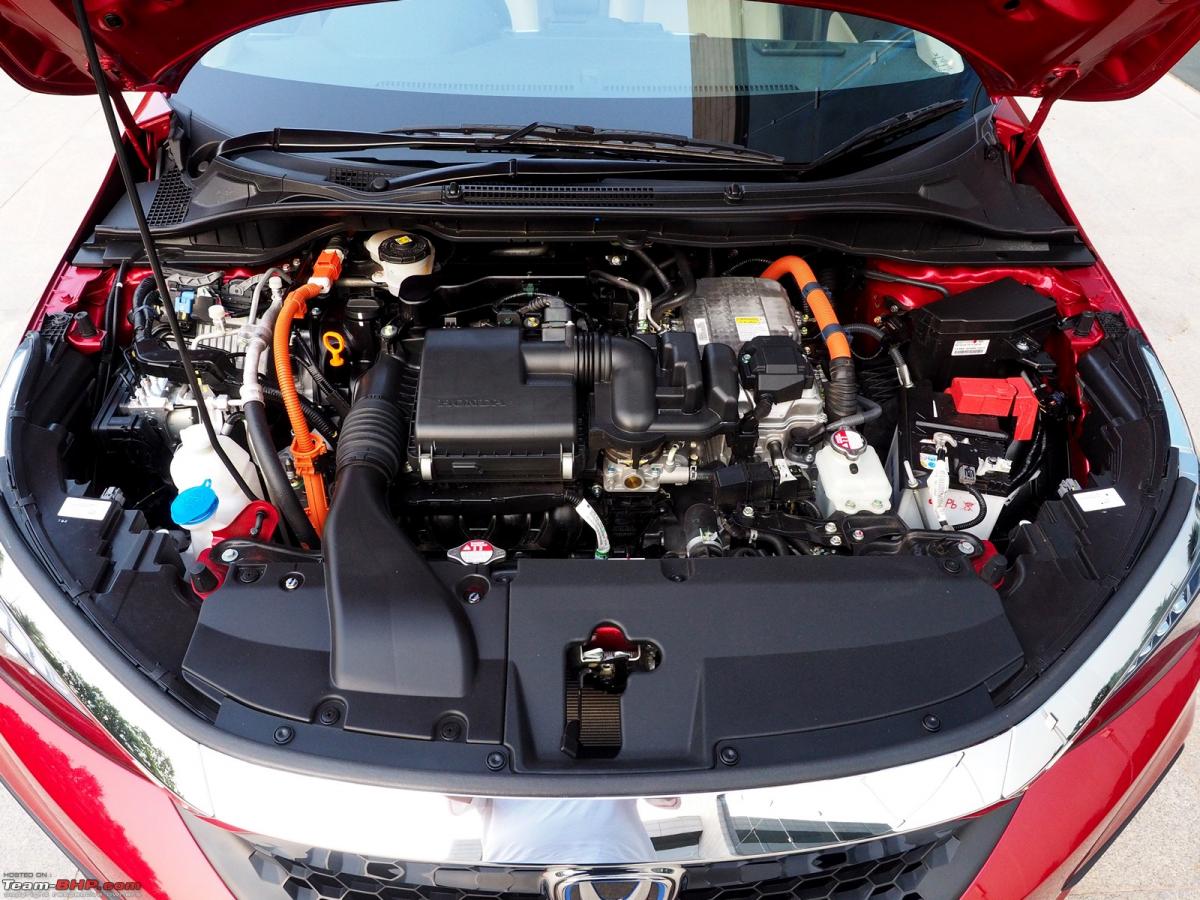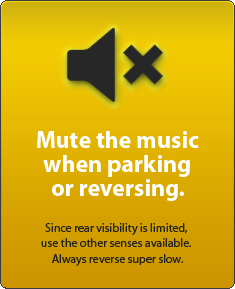News
2022 Honda City Hybrid: Observations after a day of driving
In the City Hybrid, Honda has used two electric motors. One works as a generator connected to the engine and the other works as a traction motor driving the wheels.
Driving the Honda City Hybrid
Hybrid power unit is packed tightly in the engine bay with the 1.5L petrol engine and the two electric motors:

Now that we have the nitty-gritties out of the way, let's see how the Honda City Hybrid actually feels to drive. When you start the car using the "Power" button, the only way to know that the car is on is via a small "READY" warning light in the instrument cluster. Lift your foot off the brake and the car starts creeping forward with zero noise or vibrations. It's creepy as we accidentally got down from the car while it was in D mode and turned on, but there was no engine running sound to warn us! This could even be a problem for pedestrians and Honda actually has an external acoustic warning system that plays a sci-fi whine when car is moving in EV mode. This sound can't be heard inside the cabin.
At slow speeds inside town, the City hybrid is effortless to drive. It tries to stay in EV mode as much as possible and occasionally, you will faintly feel the IC engine turn on to charge the battery and then, turn off again after a while. If you prod the accelerator a little more to close a gap, the IC engine kicks in and provides the required shove. While there is good amount of torque available from standstill, the City Hybrid will not leave the traffic lights in a hurry. It's more relaxed acceleration than urgent. If you have a relaxed driving style, the City offers a calm and serene driving experience like nothing else. You won't feel tired even after hours driving it in traffic. We were looking around for places with more traffic just to see if there was something that would catch it out.
On the other hand, if you drive enthusiastically and with a heavier right foot, it's a very alien experience. Press the throttle hard and you hear the IC engine fire up and scream at high revs (no tachometer, so we have no clue at what rpm), but this high revving has no correlation with what is really happening on the road, which is smooth linear acceleration albeit a little faster than normal. That's because the IC engine is actually revving up to charge the batteries as well as drive the generator to, in turn, give more power to the traction motor. What's even more freaky is that when you do floor the A-pedal, you actually hear the revs go up and then you hear a blip that resembles an upshift and then again after a few seconds, the throttle blips like an upshift to the next gear. This makes no sense as there is no gearbox and you don't actually feel any interruption in power delivery. It's just the sound of revs changing. Initially, you think that this must be some fake sound from the speakers, but then you realise that the engine is actually replicating upshifts by changing rpms with no change in power delivery. Honda have simply engineered the rpm to blip to give the feeling of driving a car with a gearbox. With all the artificial feel of gear shifts and high rpm screaming drama, the actual on-road acceleration is pretty decent. The City gets up to triple digit speeds reasonably quickly.
Out on the highway, the City Hybrid responds to throttle inputs in a more linear manner. At around 80 km/h you can see a small symbol light up on the power flow meter indicating that the clutch has engaged the engine directly. Speed changes are more linear with throttle inputs and you can effortlessly cruise at triple digit speeds. When you do want to speed up to slot into a gap, the Hybrid unit disengages the mechanical clutch and seamlessly goes back into hybrid model. That said, don't expect to close tight gaps or pull off overtaking manoeuvres on a single lane carriage way without some planning. The trick is to be progressive with the throttle and not keep stomping on it expecting instant acceleration. The difference between the regular City and the Hybrid is like two different employees in a team - one when pushed hard will make noise initially, but will ultimately deliver. The other when pushed hard will analyse, assess and deliver quickly and calmly.
All this culminates down to one thing and that's fuel efficiency. Honda claims an FE figure of 26.5 km/l for the City Hybrid. We drove normally through a crowded town, then through some narrow single lane village roads and finally on a 6-lane highway towards Bangalore Airport. The total distance was 90 km and we weren't trying to be frugal or hyper-miling. We managed 21.1 km/l till we stopped for 20 minutes to take pictures and the air-con reduced the figure to 20.6 Kmpl. This translates to comfortable 20+km/l in real world city usage and probably 10% lower out on the highway.
Even though the hybrid system feels and is completely disconnected, it was quite a lot of fun watching the car change between modes on the MID seamlessly and just watch the fuel efficiency gauge show 20+ km/l. In fact, it was more entertaining than the regular City CVT.
Even with a refined petrol motor and electric operation, Honda have given insulation under the bonnet:

Orange cables indicate high voltage lines. The lines to the left are for powering the electric water pump and electric AC compressor from the battery and the one on the right is the power cable from the battery to the electric motor:

What's intriguing is that the aluminum box is the primary power unit of this car with two motors inside. The IC engine to the left is for supporting the electric unit. Notice the 2 hoses at the front:

The 2 hoses go to a small radiator that sits behind the fog lamp but is fed air from the center of the grill. The radiator is for cooling the power unit:

IC engine mounts look beefed up for the constant on/off that happens in hybrid mode to ensure that occupants don't feel the motor turning on and off:

Standard 12V battery is mainly for powering the accessories inside the cabin:

Warning on the bonnet lid indicates that the Li-ion battery needs to be used once every 3 months:

Underbody is well protected as it should be for a complex hybrid unit:

Gear shifter has no Sport mode. The Econ button just dulls throttle response but doesn't change the hybrid operation. B mode is use for driving downhill with the paddle used for adjusting the regen level:

Real world FE of 20 km/l is easily achievable. This is what we got after 90 km of driving in mixed conditions of single lane village roads, crowded city roads and open highways:

Notice the power flow diagram below on the MID. When you see a small gear lever in between the power flow it indicates that the mechanical clutch is engaged and the IC engine is mechanically connected to the wheels:

Using the paddles in D mode adjusts the regen level. Here you can see regen level is set to max (level 3) depicted by the 3 down arrows next to the D symbol. In the D mode regen goes off after a few seconds to the default mode. The idea is to use this mode when driving in the hills or when you want to manually enable higher regen when rolling to a stop light. It's very cool to just click on the paddle when rolling to a stop light vs pressing the brake pedal:

If you want to keep the regen permanently on, you can move the gear shifter to "B" mode and then use the paddles to adjust the regen level. This will always keep the regen level to what you set using the paddles:

Suspension
The dynamics of the Hybrid City are quite different from the non-hybrid version. This is primarily due to the fact that the Hybrid has a kerb weight of 1,280 kg, which is 127 kg more than the petrol's 1,153 kg. This extra weight has been distributed at the front with the electric motors and the rear with the battery pack in the boot right between the rear wheels and low down. As a result, the suspension has been beefed up and is now on the firmer side to deal with the additional heft. Overall, the City Hybrid manages the extra weight very well.
Ride Comfort
The ride is very comfortable at slow speeds and it's only the sharp potholes and big speed breakers that are noticeable inside the cabin. The suspension is still on the softer side giving it a plush ride, but now, with a bit of underlying firmness.
Handling & Dynamics
Moderator Ajmat mentioned that it was a doddle to drive in city conditions and even on straight highways. As speeds build up car remains stable and the extra weight of the battery in the rear even keeps the rear of the City hybrid planted with none of the perceived bounciness that was reported from the non-hybrid version.
Handling too is very decent as I found out with Ajmat approaching a trumpet ramp of the airport flyover with no signs of slowing down. The City Hybrid held its line well with no squeal from the tyres. The car will maintain its line through a corner well partially due to the lower center of gravity and the weight distribution. However, there is no feedback about the limits. One of the most unnerving traits about the City Hybrid is the fact that you cannot throttle steer during hard cornering and balance the car on the throttle. Usually you apply throttle to power out of a corner and shift the weight to the rear or lift off to tuck into a corner tighter. Since the throttle has no direct correlation, even when you lift off, the hybrid system decides whether to keep powering or coast or regen. The good thing is that you can't disturb the car easily mid-corner. On the same trumpet flyover loop, Ajmat had lost the rear of the Civic mid-corner, but then caught it just in time.
Overall the City Hybrid's handling is very inert, but it handles aggressive manoeuvres quite well. You need to just focus on steering and not bother about anything else.
Braking
The City Hybrid's braking is quite different from the regular City's. For a start, the rear now gets much needed disc brakes. Secondly, it now has an electric servo braking system that does the regenerative braking initially and then applies the regular friction brakes. Just like the power train, the system is seamless and actually has some amount of feel. Usually, the regen brakes are completely devoid of feel and you always end up misjudging the braking point. In the City Hybrid, this is not the case. The brake feel is very natural and progressive and we couldn't make out whether it was the regen system of the friction brakes doing the braking. Braking from high speeds is confidence-inspiring as well.
Continue reading the discussion on the 2022 Honda City Hybrid on our forum.



















